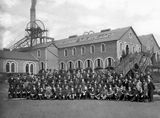| |

© RCAHMS |
|
Visit to colliery by Mining Institute of Scotland,
August 1899
Established by the Bent Colliery Company
on the east bank of the River Clyde at Bothwellhaugh in 1884, Hamilton
Palace Colliery was operational until 1959. At its peak in 1948
it had a workforce of 605 employees and annually produced 137,500
tons of rich coal for house, gas and manufacturing use from two
main shafts, each 291m deep. This colliery stood about 2km north
of Hamilton Palace but the underground workings associated with
its twin mine-shafts extended mainly in its direction, underneath
Hamilton Low Parks. They were instrumental in creating structural
instability and subsidence in the area, ultimately contributing
to the demolition of Hamilton Palace in the 1920s.
|
|
| |
This image shows members of the Mining Institute
of Scotland assembled for a group photograph on the occasion of
their visit to the colliery on 10 August, 1899. Immediately behind
the group there are single- and two-storeyed ranges of colliery
buildings, brick-built with arcades and margins picked out in paler-coloured
brick creating a distinctive polychromatic effect. In the background,
in front of a tall chimney, the headstock of one winding engine
serving one of the mine-shafts and part of the second are clearly
visible.
The visit of the Mining Institute probably reflects
the fact that a number of the collieries in the Hamilton area were,
for their time, technologically very advanced and attracted special
interest. Earnock Colliery, for example, was among the pioneering
sites, if not the first, in the use of electricity underground.
|
|